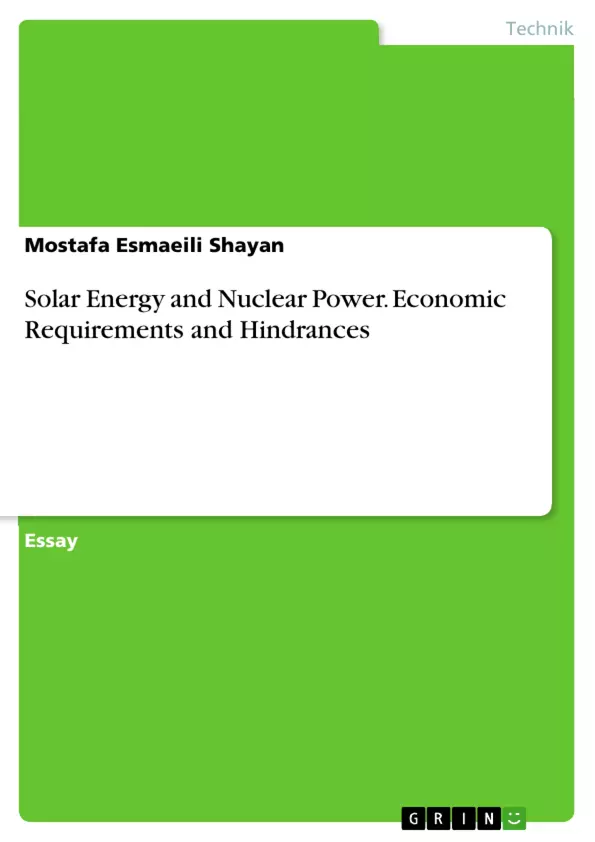This essay puts forward an inquiry on the economic and knowledge-related factors of building solar panels and nuclear power plants.
Both Solar Energy and nuclear Energy face significant economic challenges. Sustainable energy costs it has traditionally been greater than any of those associated with the growth of fossil-fuel power generation, although the costs of renewable energy technologies (especially photovoltaic) have dropped. Furthermore, capital costs remain a big challenge in the nuclear generation. In many nations, the cost of building small nuclear power plants is quite large due to time, technology, environmental and safety challenges for consumers. Such problems might not be as big for state-owned corporations or controlled industries for which utilities have quick access to cheap resources, and this partially explains why the interest for nuclear reactors in Asia is far greater than in the US or Europe. Learning could help decrease costs for both types of technologies, but the track record for learning-by-doing in the nuclear sector is not good.
Inhaltsverzeichnis
- 1. Introduction
- 2. Solar Energy
- 2.1 Advantages of Solar Energy
- 2.2 Disadvantages of Solar energy
- 2.3 Environmental impacts of solar power systems
- 2.4 Solar energy's potential
- 3. Nuclear Energy
- 3.1 Nuclear power is the result of nuclear fission
- 3.2 Advantages of Nuclear Energy
- 3.3 Advantages of Nuclear Energy
- 3.4 Disadvantages of Nuclear
Zielsetzung und Themenschwerpunkte
Diese Arbeit untersucht die Herausforderungen und das Potential von Solarenergie und Kernenergie als nachhaltige Energiequellen. Es werden die jeweiligen Vor- und Nachteile beider Technologien im Detail beleuchtet und deren Rolle im Kontext des globalen Energiebedarfs diskutiert.
- Wirtschaftliche Aspekte der Solarenergie- und Kernenergieproduktion
- Umweltbelastung und Nachhaltigkeit beider Technologien
- Vergleich der Vor- und Nachteile von Solarenergie und Kernenergie
- Technologischer Fortschritt und zukünftige Entwicklungspotenziale
- Die Rolle beider Energiequellen im globalen Energiemix
Zusammenfassung der Kapitel
1. Introduction: Das einleitende Kapitel beschreibt die Sonne als Kernfusionsreaktor und die enorme Energiemenge, die sie produziert. Es werden die Prinzipien der Solarenergiegewinnung und der Kernspaltung erläutert und der aktuelle weltweite Stand der Nutzung von Kernkraftwerken dargestellt. Die Bedeutung der Energiewende und der Übergang zu nachhaltigen Energiequellen werden hervorgehoben, wobei die Herausforderungen und das Potential sowohl der Solarenergie als auch der Kernenergie angesprochen werden. Der globale Energiebedarf und die unterschiedliche Akzeptanz von Kernenergie in verschiedenen Ländern werden ebenfalls thematisiert.
2. Solar Energy: Dieses Kapitel bietet einen umfassenden Überblick über die Solarenergietechnologie. Es werden die verschiedenen Arten der Solarenergienutzung (z.B. Photovoltaik, Solarthermie) detailliert beschrieben, sowie die Vor- und Nachteile der Technologie im Hinblick auf Umweltverträglichkeit, Wirtschaftlichkeit und technische Machbarkeit erörtert. Besondere Aufmerksamkeit wird den Vorteilen wie der einfachen Installation, der geringen Wartung und der erneuerbaren Natur der Energiequelle gewidmet. Gleichzeitig werden die Herausforderungen wie die Abhängigkeit von Wetterbedingungen und die Notwendigkeit effizienter Energiespeichertechnologien beleuchtet. Das Kapitel zeigt, wie Solarenergie einen wichtigen Beitrag zu einem nachhaltigen Energiesystem leisten kann und hebt die Bedeutung weiterer Forschung und Entwicklung hervor, um die bestehenden Limitationen zu überwinden.
Schlüsselwörter
Solarenergie, Kernenergie, Erneuerbare Energien, Kraftwerke, Technologie, Nachhaltigkeit, Wirtschaftlichkeit, Umweltverträglichkeit, Energiespeicher, Kernspaltung, globale Energieversorgung.
Häufig gestellte Fragen zum Dokument: Solarenergie und Kernenergie
Was ist der Inhalt dieses Dokuments?
Das Dokument bietet einen umfassenden Überblick über Solarenergie und Kernenergie als nachhaltige Energiequellen. Es beinhaltet ein Inhaltsverzeichnis, die Zielsetzung und Themenschwerpunkte, Kapitelzusammenfassungen und Schlüsselwörter. Die Arbeit untersucht detailliert die Vor- und Nachteile beider Technologien und diskutiert deren Rolle im globalen Energiebedarf.
Welche Themen werden im Dokument behandelt?
Die zentralen Themen sind die wirtschaftlichen Aspekte, die Umweltbelastung und Nachhaltigkeit, der Vergleich der Vor- und Nachteile, der technologische Fortschritt und zukünftige Entwicklungspotenziale sowie die Rolle beider Energiequellen im globalen Energiemix von Solarenergie und Kernenergie.
Welche Kapitel umfasst das Dokument?
Das Dokument enthält mindestens drei Kapitel: Eine Einleitung (Kapitel 1), ein Kapitel über Solarenergie (Kapitel 2) und ein Kapitel über Kernenergie (Kapitel 3). Kapitel 2 und 3 behandeln jeweils die Vorteile, Nachteile und den Einfluss auf die Umwelt der jeweiligen Energiequelle. Die einzelnen Unterkapitel gehen detailliert auf verschiedene Aspekte ein.
Was ist die Zielsetzung der Arbeit?
Die Arbeit untersucht die Herausforderungen und das Potential von Solarenergie und Kernenergie als nachhaltige Energiequellen. Sie beleuchtet detailliert die Vor- und Nachteile beider Technologien und diskutiert deren Rolle im Kontext des globalen Energiebedarfs.
Welche Schlüsselwörter beschreiben den Inhalt?
Schlüsselwörter sind: Solarenergie, Kernenergie, Erneuerbare Energien, Kraftwerke, Technologie, Nachhaltigkeit, Wirtschaftlichkeit, Umweltverträglichkeit, Energiespeicher, Kernspaltung, globale Energieversorgung.
Was wird in der Einleitung (Kapitel 1) beschrieben?
Die Einleitung beschreibt die Sonne als Kernfusionsreaktor und die enorme Energiemenge, die sie produziert. Es werden die Prinzipien der Solarenergiegewinnung und der Kernspaltung erläutert, der aktuelle weltweite Stand der Nutzung von Kernkraftwerken dargestellt und die Bedeutung der Energiewende hervorgehoben. Herausforderungen und Potential von Solarenergie und Kernenergie, der globale Energiebedarf und die unterschiedliche Akzeptanz von Kernenergie werden thematisiert.
Was wird im Kapitel über Solarenergie (Kapitel 2) behandelt?
Kapitel 2 bietet einen umfassenden Überblick über die Solarenergietechnologie, beschreibt verschiedene Arten der Solarenergienutzung (Photovoltaik, Solarthermie) und erörtert Vor- und Nachteile hinsichtlich Umweltverträglichkeit, Wirtschaftlichkeit und technischer Machbarkeit. Es werden Vorteile wie einfache Installation und geringe Wartung hervorgehoben, aber auch Herausforderungen wie die Abhängigkeit von Wetterbedingungen und die Notwendigkeit effizienter Energiespeichertechnologien beleuchtet. Das Kapitel zeigt den Beitrag der Solarenergie zu einem nachhaltigen Energiesystem und hebt die Bedeutung weiterer Forschung und Entwicklung hervor.
Gibt es Informationen über Kernenergie?
Ja, das Dokument enthält ein Kapitel (Kapitel 3) über Kernenergie. Dieses Kapitel befasst sich unter anderem mit der Kernfission als Grundlage der Kernenergiegewinnung sowie den Vor- und Nachteilen dieser Technologie. Die genauen Inhalte des Kapitels über Kernenergie sind aus dem gegebenen Auszug nicht vollständig ersichtlich.
- Quote paper
- Mostafa Esmaeili Shayan (Author), 2020, Solar Energy and Nuclear Power. Economic Requirements and Hindrances, Munich, GRIN Verlag, https://www.grin.com/document/922228



